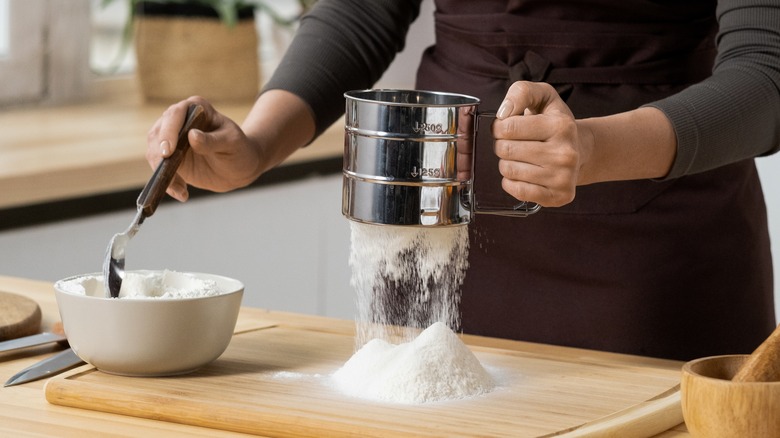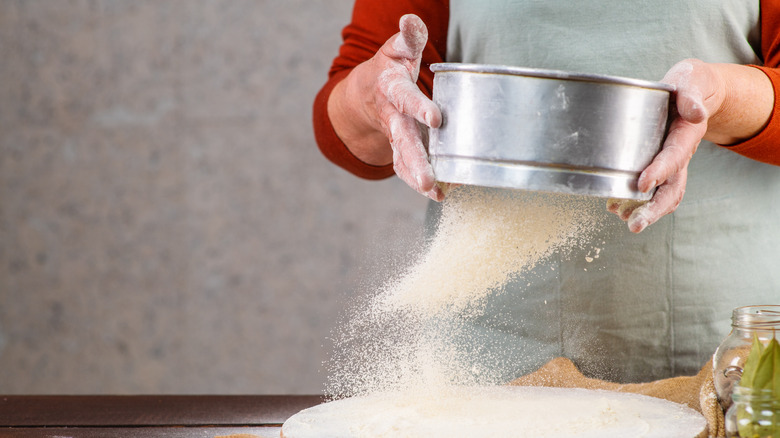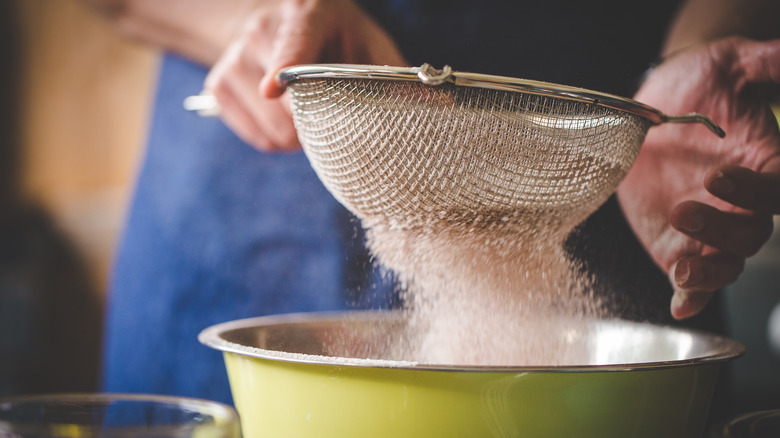Should You Sift Flour Before Or After Measuring It?
Recipes are written with exacting, specific language, and your success in the kitchen can hinge on knowing how to interpret the way a recipe writer intended the ingredients to be prepared. One of the biggest culprits of this is the second most important question in baking: should you sift your flour before or after you measure it? (The first most important question in baking is, "do I really need to sift my flour?" and we answer that in here, too.)
If a recipe is written to say "1 cup flour, sifted," then you measure first, sift second. If the recipe is written to say "1 cup sifted flour," you sift the flour and then measure it. Easy, right? But what difference does it make, really?
Think about it as a Tetris game, and we'll demonstrate with baby carrots. If the recipe calls for one cup of baby carrots, chopped, you'll be measuring out the disheveled puzzle pieces that are baby carrots into your measuring cup. There's a lot of empty space in that chaos. If you chop them first, they fit together a lot better, slotting into each other and taking up less space — you'll end up with a much different volume of baby carrots from one to the other. In the case of sifting flour, you're adding all that air into your measurement.
Do I really need to sift my flour?
Back in the day, flour wasn't as well refined as it is now. This made sifting an important step to remove debris from the milling and packing process. These days, your five-pound bag of flour is a lot less likely to include husks and seeds, but it is way more likely to be densely machine packed. There are two reasons to sift your flour: to break up tight clumps and make your flour more airy, and to get an accurate measurement.
Volume measurements are variable. You could scoop densely packed flour into your measuring cup and get a wildly different amount of it than if you were to sift it and then measure it. This will affect the ratios of your recipe, thereby affecting the chemistry, thereby affecting its outcome. Could you measure by weight and not have to sift your flour? Well, maybe, depending on what you're making.
If you're making a particularly delicate recipe like chiffon cake, you need an even disbursement of your ingredients without over-mixing. Either you'll need to mix so thoroughly that your cake will deflate, or clumps of flour will show up in your cake and wreck the light crumb.
Recipes that improve with sifting
"I like clumps of flour in my food," said no one, ever. Sometimes you'll get the instruction to sift right in the ingredients list, but others will have you sift your flour and other dry ingredients together into a bowl to best distribute them evenly. Still not sure? When in doubt, sift your flour after measuring. There's never been a time when dry flour has been sifted too much after measuring.
This recipe for chocolate chip cookies has you sift together the flour, leavening agents, and salt after measuring, which will assist in creating an even bake in your batch of cookies. This method of turning leftover mashed potatoes into gnocchi sifts flour over the potatoes for an even distribution that doesn't leave clumps, allowing you to be gentle in mixing to avoid gluey gnocchi. This peach cake sifts twice: you're using sifted flour and you're sifting together the dry ingredients. Though that can seem excessive, aerating the flour and properly dispersing the leaveners is important to baking a fruit-topped cake that isn't stodgy.
Do you need to go out a buy a special flour sifter? Of course not — unless you want to; we're not stopping you. You can just use a sieve; toss your flour in and sift right over the bowl for "flour, sifted" and onto a piece of parchment for easy transport of "sifted flour" into your measuring cup.


